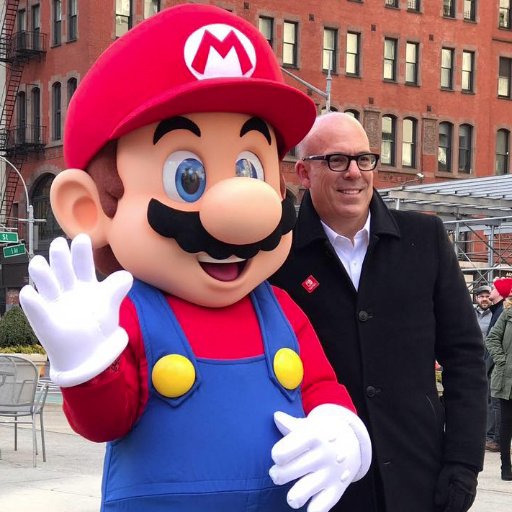Nintendo is on a roll with its Nintendo Switch and Nintendo 3DS consoles. Although some in the industry had counted the Japanese game maker out after Wii U failed to build on the Wii’s global success, they’re singing a different tune now that the company can’t keep up with demand for the Switch.
Nintendo was one of the first game companies to successfully expand its game franchises to merchandise, which has helped the company attract new gamers. Doug Bowser, senior vice president of sales and marketing at Nintendo of America, explains to AListDaily how the company continues to market games through multiple touchpoints.
Who is Nintendo targeting today when marketing the Switch?
We continue to target a couple of audiences. We have our Nintendo fans, the active gaming group, and then we have kids and parents. If you look at the copy that we’ve created thus far, the spots have a different tonality and a different look and feel. Some will incorporate more kids and family-oriented games like Arms and Mario Kart together as an example, and others will include more active or core gaming. We’re trying to balance the messaging that way because we believe Nintendo Switch can appeal to a broad audience. If you look at the software that’s coming onto the platform, it runs the gamut in terms of genres. Now our job, from a marketing perspective, is to make sure that each one of those key audiences understands how those titles fits their needs.
What opportunities have social media platforms and livestreaming opened up as marketing vehicles for Nintendo?
We’re still very active in television, but we also have used things like the Directs as a powerful medium. Then we use our social media space to amplify those messages. They become really beneficial for the amplification of the other messages. What you can do with that draw consumers back in to spend more time watching one of those Directs or one of those feeds and learning more about the content itself.
When so many people know Mario, Link and other Nintendo characters, what are the challenges of getting audiences to pick up a Switch?
First of all, the content, even if they know a Mario, it’s got to be a unique Mario experience on Switch. You can see what we’ve done with Super Mario Odyssey—it’s very, different Mario game than we’ve seen in the last few iterations.
Legend of Zelda: Breath of the Wild is a great example. People knew Link and the core came quickly, but what’s been amazing is the word-of-mouth perspective of people who have played the game and engaged. The word-of-mouth has expanded so people that have never played a Zelda game before, myself included, are now diving in and embracing the gameplay. There’s always a chance to engage and bring new consumers into your franchises.
How do older generations, who grew up playing Nintendo consoles and now have kids themselves, impact your marketing?
When I talked about the kids and parents campaigns, some of the communications we have is to parents that may not have gamed before. But there’s a bit of nostalgia in some of our advertising for those parents that grew up gaming and now want to introduce it to their kids. It’s another great catalyst to get them to jump in and start bringing their kids to games. What we love about our properties is that so many of them are family and kid friendly, and it’s a great place for parents to engage in gaming with their kids.
How have you seen the success of Nintendo games on mobile devices impact the business, especially since some people thought mobile releases would cannibalize Nintendo 3DS sales?
The 3DS business continues to be strong. It was the only platform last year that grew year-over-year across all platform developers. What we’ve seen is that they’re complementary. When we launched Pokémon GO with Niantic, there was a direct impact on Pokémon hardware and software sales increasing. Mobile games actually bring new players into the franchises. They engaged in that content and wanted more of that experience, so their next purchase was more of the dedicated handheld and software side.
It seems like there’s more Nintendo merchandise out now than ever before. What role does retail merchandizing featuring Nintendo characters play for the brand today?
There’s a bit more. We’re making a conscious effort at retail right now to really improve our footprint overall because that’s a great touchpoint. For us, it’s a marketing touchpoint. It’s a chance for consumers to learn more about Nintendo properties and help our retailers sell Nintendo content. One thing we are trying to do when you say you see more is we are trying to bring together hardware, software, our accessories and even other licensed goods, because there are other licensed goods in the stores. Products like t-shirts, backpacks and other properties that we’re trying to bring into that section allow people to experience more of Nintendo and it exposes the brand a little bit better at retail.
The last few Nintendo E3 booths have been like theme parks. What impact do you see the Universal Studios Nintendo theme parks having on the brand?
One of our goals is to increase the amount of touchpoints that consumers have with Nintendo. That’s how you drive and grow the franchise and bring more people into our various forms of gaming. Universal is going to be a great example of that with the number of people that walk through a Universal theme park every year. A lot of them are younger kids who may not have picked up a 3DS yet, may not have a Switch at home, or may not have played on the mobile device. It introduces that IP and those characters to them and they embrace that. Then it helps us to expand that ecosystem, so they start coming more into our dedicated gaming business or into our mobile business.

